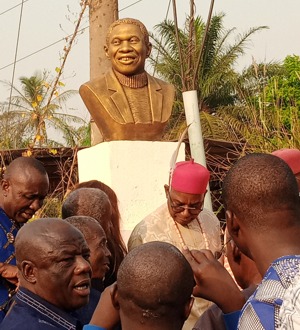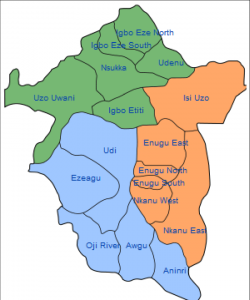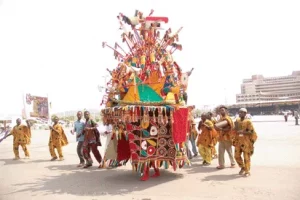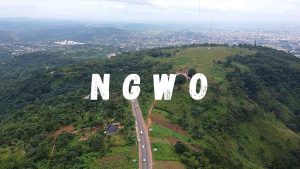
In this context, the word “Abor” refers to the two separate communities of Abor and UmuavuluAbor in Enugu State’s Udi Local Government Area. UmuavuluAbori is a descendant of Abor; she has grown from Abor; and, as her name suggests, she is still proudly Abor. She is unable to distance herself from that illustrious heritage. HRH Igwe C. Ngwudile, Agodom III of Abor, and HRM Igwe Dr. C. C. Njeze, Ujaligwa II of Umuavulu-Abor, are the traditional rulers of these two regions, respectively.
As the crow flies (in a straight line), Abor is located on a highland about two kilometers from Enugu’s famous Milliken Hill. Abor and Ninth Mile Corner, Ngwo are separated by about one kilometer along the old road to Nsukka, the university town. The Ekulu River and the towns of Eke and Ebe border it to the east and west, respectively. The towns of Ukana and Ngwo, both of which have Milliken Hill, are located to the north and south, respectively, of Abor.
Basil Davidson lamented in “The Growth of African Civilization, West African 1000-1800” that “little is known about the remote past of the Ibo and their neighbors,” and this is something that would come up again if one tried to research the history of Abor. Isichei (1976) made a similar observation, noting that it is particularly difficult for Igbo historians to write about the centuries between the ninth and the nineteenth. Yes, archeological evidence shows that the Igbo have lived in their culture area from the first millennium (the Igbo-Ukwu finds, for example) (10th Century). Additionally, there is a wealth of oral and written history about the Igbo of the 19th century.
The origination of Abor
Two explanations have been put out to explain how Abor got its start. The Ojebe-Ogene idea, which has mostly been promoted by both oral and written media, is the more well-known. According to the story, Abor was a progeny of the legendary creature Ojebe-Ogene. According to legend, Ojebe-Ogene, the mother of the organization, had seven sons with several husbands. The first son of Ojebe-Ogene was Ebe, whose father was the hunter Eriudene. OjebeOgene went on and met IyimeAwubu before giving birth to Abor, OjebeOgene’s second kid, with him when she was unable to continue living with the hunter, Ebe’s father.She eventually moved away from Abor’s father and went to different places before giving birth to Ukana and Awhum, whose fathers were Ebenebe and UjomEkete, respectively.
It is claimed that Okpatu and Umulumgbe share the same father, Edem; however, according to certain sources, UkwuEdem is credited with building Okpata while Edem is the father of Umulumgbe. It is obvious that Edem is present in each and every narrative. Ojimanam is claimed to have fathered Ukehe, the last of her offspring, even though some traditions refer to him as OjimeIgweonyi.
According to the hypothesis, the mothers of all these various communities were Ojebe-Ogene, but the dads were all distinct. Thus, the seven sons of the woman known as OjebeOgene are Ebe, Abor, Ukana, Awhum (Ohum), Okpatu, Umulumgbe, and Ukehe. The OjebeOgenelegend has additional in-depth accounts, which we are unable to fit here.
Eight sons are born to Abor, Ojebe-second Ogene’s son. The eight Abor settlements were established by these sons. The eight settlements of Abor are the subject of three distinct legends, according to Okolo (2000). According to one account, Abor had three wives: the first bore him three sons, Ugwunani, Ozalla, and Amukwu (referred to collectively as Ikenge); the second, according to this account, bore him four sons, Ebongwu, Ngwuagu, Ubiekpo, and Amezike (referred to collectively as Ibute); and the third, a single son, Umuavulu. According to a second tradition, Abor only had one wife who gave birth to all eight settlements.
The third mythology provides no other explanation for the creation of eight villages other than the claim that Abor had three sons, Ikenge, Ibute, and Umuavulu. Okolo believes that the first legend he provided sounded more palatable than the other two. But to the current researcher, the presence of eight villages—Ugwunani, Ozalla, Amukwu, Dinigweze, Dinunaobe, Ubiekpo, Amaezike, and Umuavulu—in Abor, Aborn’isato, is clear. These settlements show that Abor really had eight kids, whether he had three wives or one. In later years, it’s possible that the Ibute, Ikenge, and Umuavulu differences were used to ensure an equitable division of the town’s resources, assets, liabilities, and obligations.These are Abor’s three zones or sections. The names Dinigweze and Dinunobe are two that are no longer in use. The names that are now preferred are Ebongwu and Ngwuagu. These alterations were brought about by some prior events. These incidents have not yet been thoroughly investigated and recorded.
However, there are allegedly some Abor natives living abroad. The term “Abor” in this context does not necessarily relate to recent Abor immigrants to other regions of the globe who visit their own country on a regular or irregular basis. The Abor natives who have moved to and settled in other nearby localities and may now be regarded as residents of these other areas are the ones who are being discussed here. The Umuebo hamlet of Akpuoga Nike, for instance, may trace its roots back to the Ikeaduba family of the nearby Ubiekpo village (Okamkpa, 2019). For instance, the current Commissioner for Works and Infrastructure in Enugu State, Engr. (Sir) Greg Nnaji, who also hails from that hamlet, never stops mentioning his affinity and, in a sense, blood relationship with the Abor people.
Enu-Abor and Umuavulu are two other names that are frequently used to refer to the two main parts of Abor. The English meaning of the name Enu is “high” or “top.” In other words, Enu-Abor can mean “Abor on top,” “Abor on hilltop,” or “Upper section of Abor.” Ugwunani, Ozalla, Amukwu, Dinigweze, Dinunaobe, Ubiekpo, and Amaezike are among the seven villages that make up Enu-Abor, whereas Umuavulu is still only one village.
Due to its location in the deepest, oldest, and most distant part of Abor, Ugwunani village is thought to be the oldest of the sons of Abor. It’s possible that Abor first moved there during the 12th–18th century slave trade. People then preferred to settle in areas that would keep them hidden from outside influences, especially slave raiders, displeasing neighbors, or wild animals. It is thought that Umuavulu is the youngest, which explains why it is located where it is today.
Their way of worship
The manner of worship practiced by the Abor group is one of its distinctive characteristics. They are mainly Christians today, and the majority of them practice Roman Catholicism. Apart from the “ani,” which the Igbo people worship and to which they offer sacrifices and respect, there was a strong belief in ancestral spirits in earlier times. The ghosts that represent the deceased ancestors occasionally make an appearance so that people might adore and revere them. These spirits are not known in Abor as “Mmanwu,” as they are in the majority of Igbo communities, or as “Omaba,” as they are in other Igbo communities.They are known as the “Odomagana” or simply “the Odo.” The origin of the Odo in Abor has always been a mystery, but it is thought that they are our noble ancestors who have passed away who occasionally visit the town to help the locals and defend them from their foes.
Abor Environment
The geographical region of Abor is known for its undulating topography, which includes hills and valleys. In the land area, there are hardly any planes. Nearly all the year’s seasons are pleasant there. Between April through November, there is rain. Typically, September is the wettest month. The terrain around Abor is relatively fertile for farming. A few of the crops that thrive in the region are pepper, yams, cocoyams, groundnuts, and palm goods. For instance, the coco yam from Abor, known as “edeAbor,” used to be the most in-demand item in the marketplaces around Enugu.
The same is true of the pepper and groundnuts grown by Abor women farmers and sold to Enugu traders. Due to the fact that Abor women and people seldom ever farm on a big scale in the current years, partly as a result of threats from the Fulani herders in their farmlands, onuagu, these crops have virtually completely disappeared from Abor. Cassava, oil bean seeds, and mkpuruanara are three more significant crops that thrive in the region (garden eggs). Many tasty African meals are prepared using these crops.


